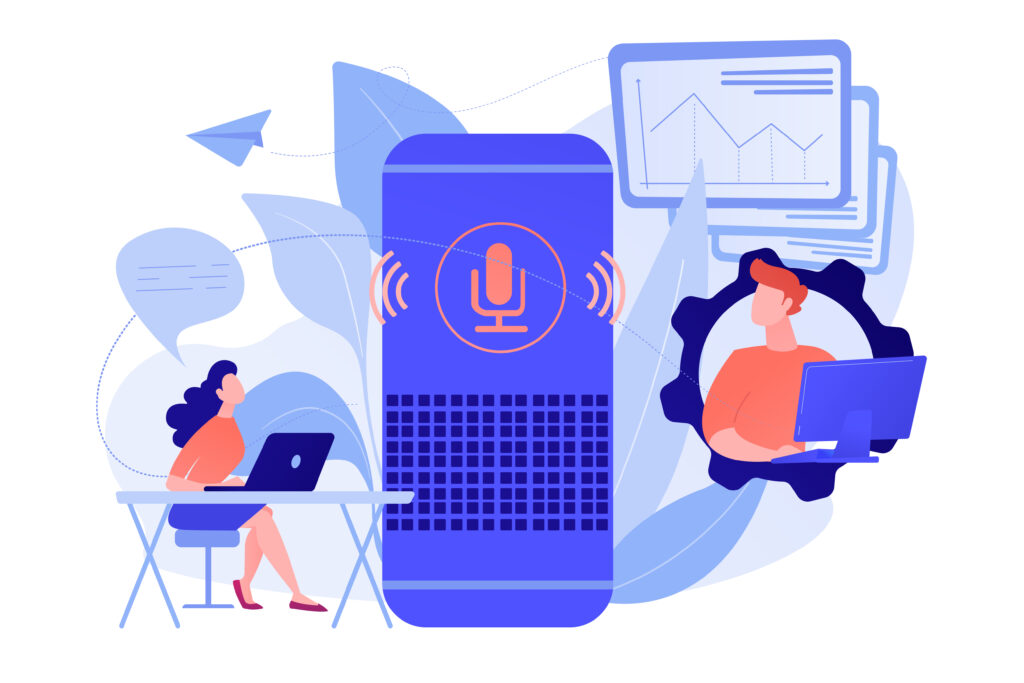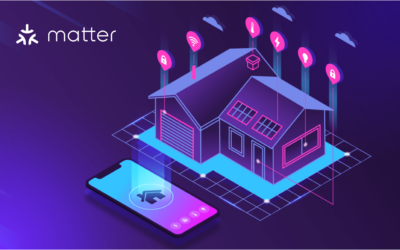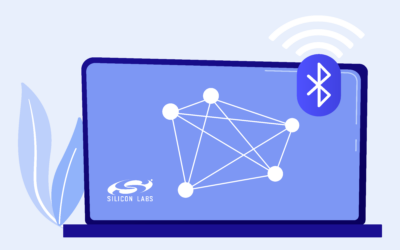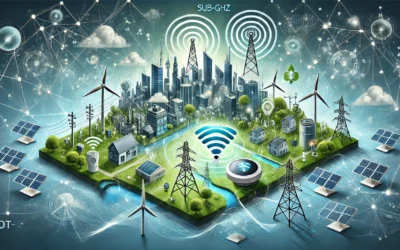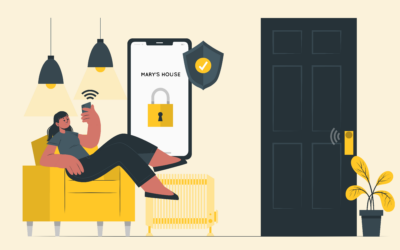Table of content
- Building a Voice Recognition App for Controlling IoT Devices
- Cloud-Based Voice Processing – Integration
In an era of smart homes and connected living, controlling your IoT devices with just your voice has become necessary. Imagine seamlessly adjusting your thermostat, dimming the lights, or locking your front door, all with a simple command. This is done through speech recognition technologies for IoT devices, and it’s changing how we interact with our surroundings.
This blog post will explore voice-enabled applications and the concepts behind creating voice-integrated apps for smart home control.
Speech Recognition Capabilities
Adding voice functionality to an application that controls an IoT device or appliance involves integrating a voice recognition engine and a natural language processing (NLP) library into the app.
Mobile applications may incorporate speech capabilities of the following types:
- Speech-to-text
- text-to-speech
- speech translation
- speaker recognition
Voice integration for IoT devices and appliances involves enabling these devices to understand and respond to voice commands from users. These speech capabilities allow users to control and interact with their smart devices using natural language, making the user experience more convenient and intuitive.
Now, users of your products will be able to create custom keywords to activate IoT devices, call your home, and give instructions, or create automation based on certain triggers.
In voice-related technologies, “speech recognition” typically refers to converting spoken language into text, while “voice recognition” encompasses a broader range of capabilities, including recognizing unique voice characteristics—a speech recognition feature. We will use these terms interchangeably to cover various voice-related functionalities.
Integrate a Speech Recognition Solution
Voice control works by integrating speech recognition technology with apps and IoT devices. A voice-enabled device such as a smart speaker, smartphone, wearable, or table captures the audio input, which is then processed for speech recognition.
The speech recognition process involves complex algorithms and machine learning models trained on vast datasets to transcribe spoken language into text accurately.
Select a voice recognition engine compatible with your development platform and supports your needed languages.
Automatic speech recognition (ASR), also known as speech-to-text (STT), is a technology that converts spoken words into text. These services are available as APIs that developers can use to integrate speech recognition into their applications.
Popular options include:
- Google Speech-to-Text: Google’s Speech-to-Text service offers specialized machine learning models trained for different audio sources. It allows users to significantly enhance transcription accuracy by choosing the model that matches their source. This customization improves the service’s ability to recognize speech in various contexts, providing more precise and context-aware transcriptions. Users have flexibility in model selection and can specify the desired model when making transcription requests, ensuring optimal performance for their unique use cases and audio content.
- Azure AI Speech Azure AI Speech is a solution for developing high-quality voice-enabled applications. With the Speech SDK, you can transcribe speech-to-text with exceptional accuracy, generate lifelike text-to-speech voices, translate spoken audio, and even incorporate speaker recognition into your conversations. The platform allows you to create custom models tailored to your specific application using Speech Studio. It prioritizes data privacy and security by not logging your speech input during processing. Additionally, you can customize voices and models, run Speech in the cloud or at the edge in containers, and access features like real-time speech translation, speaker verification, and hands-free voice commands for IoT devices and assistants.
- Amazon Transcribe. Amazon Transcribe is an automatic speech recognition service that simplifies the integration of speech-to-text capabilities into various applications. With a wide range of features, it allows you to process both live and recorded audio or video input for accurate transcriptions. You can choose from domain-specific models, automatically identify the dominant language, and benefit from easy-to-read transcripts. It also provides timestamp generation, recognizes multiple speakers, and offers customization options such as custom vocabulary and language models. It prioritizes user safety and privacy, allowing you to filter sensitive content and even perform automatic content redaction.
- Whisper OpenAI. Whisper is an open-source automatic speech recognition (ASR) system-trained neural net. Whisper enables speech recognition capabilities for smart home applications. It has been trained on more than 680,000 hours of labeled speech data. This large and diverse training set allows it to generalize well to new datasets and tasks without requiring fine-tuning. Whisper achieves much higher accuracy and robustness than other speech recognition models when tested on speech data that is out-of-distribution from its training set. This suggests it would work reliably for smart home applications without needing customization. It has been tested on unpredictable real-world conditions like background noise, accents, and languages (multilingual speech transcription). Its multitask training approach allows a single model to handle multiple aspects of speech processing like transcription, translation, speaker ID, etc. This could simplify the integration of speech recognition into smart home systems. Whisper achieves high performance and enables rich voice control and interaction for smart homes.
Implement Speech-to-Text Conversion
A code implementation captures the audio from the user’s device and sends it to the voice recognition service. The engine will return the transcribed text of the user’s speech to the app.
The voice recognition engine is integrated into your application (voice integration). This typically involves adding NLP libraries or SDKs provided by the voice recognition service.
The code implemented processes the transcribed text using an NLP library (algorithms) that can understand the user intent and interpret the meaning of the transcribed text, extracting relevant information (keywords, phrases) from the user command or query.
Speech recognition requires dedicated speech processing libraries such as the following:
- SpaCy (open-source libraries for Natural Language Processing)
- NLTK
- Stanford CoreNLP
- Hugging Face Transformers
Natural language processing (NLP) is used to understand the meaning of your spoken commands. This process involves several techniques:
1. Tokenization: The spoken command is broken down into individual words or tokens.
2. Part-of-speech tagging: Each token is assigned a part of speech (e.g., noun, verb, adjective).
3. Parsing: The sequence of tokens is parsed to determine the syntactic structure of the command.
4. Semantics: The meaning of the command is inferred based on the syntactic structure and the meanings of the individual words.
Text Processing and Action Mapping
Once the intent is understood, the voice control system maps the intent to a specific action or command that needs to be executed within the app. For example, if the user says, “Open the garage,” the system recognizes the intent as “open” and identifies the target device as “the garage.”
The voice control system communicates with the app and IoT device over a network, often using protocols like Wi-Fi, Bluetooth, Zigbee, or cloud-based APIs. It sends the relevant command or action to the app, which interprets the command and sends the appropriate instructions to the IoT device. The IoT device then performs the desired task.
The device communication involves the following steps:
- Device discovery: Your voice assistant device or appliance broadcasts its presence using a communication protocol.
- Device pairing: You select the appliance you want to control from the list of available devices.
- Command transmission: Using the communication protocol, your voice assistant device or appliance transmits the voice command to the appliance.
- Command execution: The appliance receives the command and executes it.
The IoT device receives the command and performs the requested action, such as adjusting a thermostat, turning lights off, or locking a door.
The voice control system provides feedback to the user regarding their voice commands, such as confirming actions or acknowledging errors. This can be done through visual cues, text messages, or voice prompts.
Test Voice Integration
Thoroughly test the voice integration and functionality to ensure accurate speech-to-text conversion, correct interpretation of commands, and proper execution of actions. Refine the system based on testing results and user feedback.
Adding voice functionality requires expertise in IoT development, voice recognition technology, and natural language processing. Consider collaborating with developers or seeking guidance from experts in these areas.
Cloud-Based Voice Processing – Integration
Many IoT devices now support voice control features through built-in voice recognition capabilities or by integrating with popular third-party voice platforms like Amazon Alexa, Google Assistant, and Apple Siri. These voice interfaces allow users to control devices through natural voice commands and provide convenient hands-free control.
Cloud-based voice processing is the most efficient and effective approach for implementing voice control on consumer IoT devices. By leveraging powerful servers, advanced voice recognition algorithms, and continual improvements from large volumes of data, cloud platforms can offer accurate speech processing that would be difficult to match on local device hardware. Cloud processing also allows voice data transmission to be encrypted to help protect user privacy.
The main downsides of cloud-based processing include dependence on internet connectivity for real-time operation and risks from server outages. Some initial audio preprocessing such as wake word detection may still occur locally on devices.
Determining speech processing location requires trading off multiple factors, including latency, privacy, utility, and operating conditions. Leading platforms like Amazon Alexa and Google Assistant perform the bulk of processing in the cloud to balance these factors, only using local device resources for minimal preprocessing before securely transmitting data to cloud servers.
As many have expressed, speech recognition is a highly sought-after feature among product developers. If you’re interested in exploring the technical aspects, including software architecture, data formats, and other details related to building voice features and integrating with you IoT interfaces, please don’t hesitate to contact our team of experienced developers.

